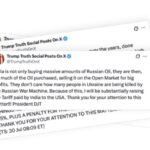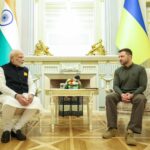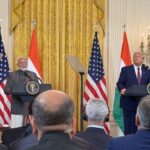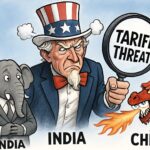It takes a simple mind to read too much into what is happening in the realm of India–United States relations—a tendency to take at face value all that is being hurled around in the name of Ukraine and India’s purchase of Russian oil.
Worse, it shows an inability to distinguish between noise and signals in international relations and diplomacy. Yes, the level of rhetoric and vitriol unleashed by senior officials of the Trump administration is unbelievable, given what has been happening in bilateral relations for more than two decades.
Or is it an old game played all over again—overenthusiastic senior officials trying to please their boss by unleashing their rants, or a boss encouraging his minions to “lay it on” and then later suggesting that things are hunky-dory, wondering what the fuss is all about? President Donald Trump is not exactly known for consistency, but in the context of the troubled environment of bilateral relations, he has rarely added his two cents. The same goes for Prime Minister Narendra Modi.
Every time President Trump referred to his personal close friendship with the Indian leader, Modi invariably touched on the warmth and depth of the bilateral relationship.
“I am pleased to announce that India and the United States of America are continuing negotiations to address the trade barriers between our two nations. I look forward to speaking with my very good friend, Prime Minister Modi, in the upcoming weeks,” President Trump wrote on his social media site.
To which Prime Minister Modi responded: “India and the US are close friends and natural partners. I am confident that our trade negotiations will pave the way for unlocking the limitless potential of the India–US partnership.”
It is tempting to read too much into the comments of President Trump, for the simple reason that he, almost in the same breath, called upon the European Union to impose a 100 percent tariff on India and China for importing Russian oil. At the same time, European capitals will likely be circumspect in following through with Trump’s suggestion, for the simple reason that they, too, stand to gain—if the analogy of gains and profits is applied evenly.
Some in the Republican administration argued that India was re-selling Russian oil for a profit, and at least one senior official went to the extent of saying that “Brahmins” of India stood to gain in the process. “India is nothing but a laundromat for the Kremlin… You got Brahmins profiteering at the expense of the Indian people. We need that to stop,” Trade Advisor Peter Navarro said.
In an interview with the Times of India, former National Security Advisor John Bolton argued that the structuring of the oil levy had two objectives: reducing Russian revenues and keeping Russian oil under a price cap so that America and Europe would not worry about increased prices.
“This is doomed to failure because it’s self-contradictory. My understanding is that much of the oil that India bought from Russia was sold to the Europeans. So, it’s a little bit hard for the Europeans to complain about this. To me, it’s further proof of incoherence within the Trump administration,” Bolton said.
At a time when there are signs of a thaw in what was once seen as bilateral ties spiraling out of control, it is necessary for both sides to scale back and find ways of getting back to the negotiating track—in this case, a trade deal. Here too, the feeling is that the two sides are deadlocked on agriculture, less on apples, oranges, and almonds, but more on dairy and agricultural products. The issue of high tariffs in India, earning it the monikers of “King” or “Maharajah,” is not anything new. Rather, it is a holdover from the first Trump administration, with levies on Harley-Davidson motorcycles held out as an example. Here again, India points out that Washington insists on addressing trade imbalances only on goods, not on services, where the United States has the upper hand.
“But this trade deficit narrative is misleading and incomplete,” argues Ajay Srivastava, Founder of the Global Trade Research Initiative, making the point that the United States rakes in between US$80 and US$85 billion every year from India through education, digital services, intellectual property royalties, arms sales, and digital platforms.
“When you factor them in, the US isn’t running a deficit with India at all—it’s sitting on a USD 35–40 billion surplus,” Srivastava maintains. “As the US pushes India to make one-sided trade concessions, New Delhi should stand firm… India is not just a passive trade partner, but a major contributor to American wealth across education, technology, finance, and defense,” he adds.
There is no question that these are delicate times, when neither side is in a position to raise the ante. Nor is it a time to believe that pinching the baby and rocking the cradle can continue indefinitely without impacting bilateral relations. In diplomacy, it is normal for leaders to step in where delegations are deadlocked. Both President Trump and Prime Minister Modi are stepping up to the plate—perhaps a quiet message for others to step back. Hopefully, the signals are being read properly.
Disclaimer: The opinions and views expressed in this article/column are those of the author(s) and do not necessarily reflect the views or positions of South Asian Herald.






